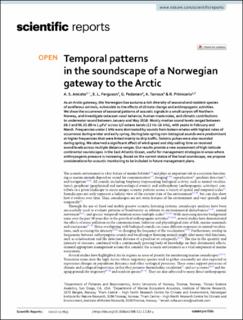Temporal patterns in the soundscape of a Norwegian gateway to the Arctic
Peer reviewed, Journal article
Published version

Åpne
Permanent lenke
https://hdl.handle.net/11250/3010637Utgivelsesdato
2022Metadata
Vis full innførselSamlinger
- Publikasjoner fra CRIStin - NINA [2364]
- Scientific publications [1392]
Originalversjon
10.1038/s41598-022-11183-ySammendrag
As an Arctic gateway, the Norwegian Sea sustains a rich diversity of seasonal and resident species of soniferous animals, vulnerable to the effects of climate change and anthropogenic activities. We show the occurrence of seasonal patterns of acoustic signals in a small canyon off Northern Norway, and investigate cetacean vocal behavior, human-made noise, and climatic contributions to underwater sound between January and May 2018. Mostly median sound levels ranged between 68.3 and 96.31 dB re 1 μPa2 across 1/3 octave bands (13 Hz–16 kHz), with peaks in February and March. Frequencies under 2 kHz were dominated by sounds from baleen whales with highest rates of occurrence during winter and early spring. During late-spring non-biological sounds were predominant at higher frequencies that were linked mainly to ship traffic. Seismic pulses were also recorded during spring. We observed a significant effect of wind speed and ship sailing time on received sound levels across multiple distance ranges. Our results provide a new assessment of high-latitude continental soundscapes in the East Atlantic Ocean, useful for management strategies in areas where anthropogenic pressure is increasing. Based on the current status of the local soundscape, we propose considerations for acoustic monitoring to be included in future management plans.
